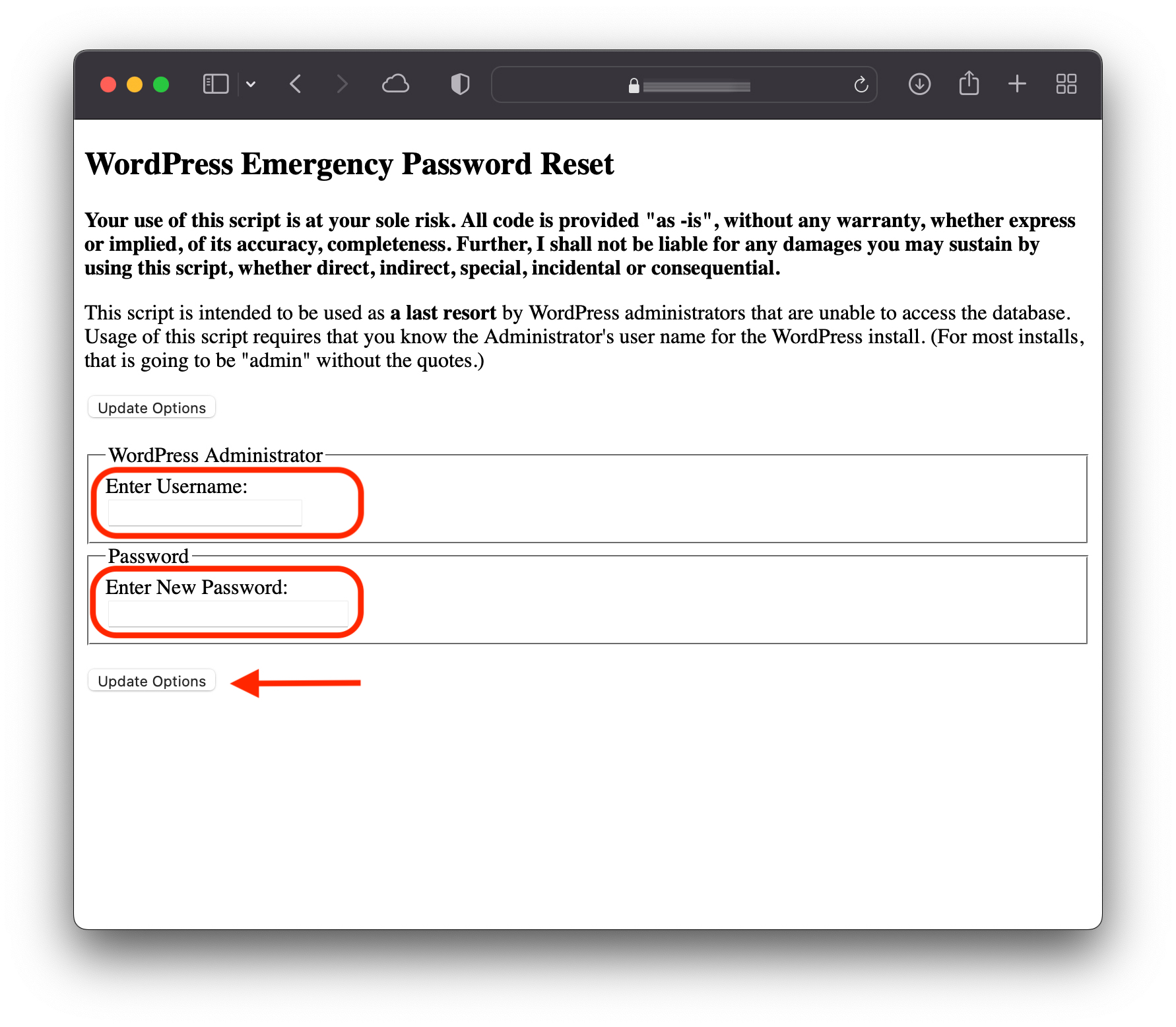Cũng có những thời điểm quan trọng khi vì nhiều lý do khác nhau, chúng tôi không còn có quyền truy cập vào địa chỉ email mà chúng tôi đã đăng ký người dùng của mình. Administrator WordPress, chúng tôi không biết thông tin đăng nhập truy cập vào cơ sở dữ liệu nữa và chúng tôi thậm chí không nhớ mật khẩu của người dùng quản trị. Trong trường hợp này, chúng tôi phải tìm giải pháp làm thế nào để đặt lại mật khẩu người dùng Administrator WordPress. Reset WordPress Administrator Password.
Metotda dưới đây, bởi đặt lại mật khẩu của người dùng WordPress yêu cầu quyền truy cập vào FTP hoặc trình quản lý tệp (thông qua cPanel) để tạo tệp trong thư mục gốc nơi blog hoặc trang web được cài đặt WordPress mà chúng tôi muốn khôi phục mật khẩu quản trị viên.
Nội dung
Cách đặt lại mật khẩu người dùng Administrator WordPress nếu chúng tôi không có quyền truy cập vào email hoặc cơ sở dữ liệu
Reset WordPress Administrator Password
1. Chúng tôi tạo trên máy chủ lưu trữ của WordPress trong thư mục gốc (public_htmlmột tệp PHP (reset_password.php, ví dụ), trong đó chúng tôi thêm mã bên dưới:
<?php
/*
This program is free software; you can redistribute it and/or modify
it under the terms of the GNU General Public License as published by
the Free Software Foundation; either version 2 of the License, or
(at your option) any later version.
This program is distributed in the hope that it will be useful,
but WITHOUT ANY WARRANTY; without even the implied warranty of
MERCHANTABILITY or FITNESS FOR A PARTICULAR PURPOSE. See the
GNU General Public License for more details.
You should have received a copy of the GNU General Public License
along with this program; if not, write to the Free Software
Foundation, Inc., 59 Temple Place, Suite 330, Boston, MA 02111-1307 USA
*/
require './wp-blog-header.php';
function meh() {
global $wpdb;
if ( isset( $_POST['update'] ) ) {
$user_login = ( empty( $_POST['e-name'] ) ? '' : sanitize_user( $_POST['e-name'] ) );
$user_pass = ( empty( $_POST[ 'e-pass' ] ) ? '' : $_POST['e-pass'] );
$answer = ( empty( $user_login ) ? '<div id="message" class="updated fade"><p><strong>The user name field is empty.</strong></p></div>' : '' );
$answer .= ( empty( $user_pass ) ? '<div id="message" class="updated fade"><p><strong>The password field is empty.</strong></p></div>' : '' );
if ( $user_login != $wpdb->get_var( "SELECT user_login FROM $wpdb->users WHERE ID = '1' LIMIT 1" ) ) {
$answer .="<div id='message' class='updated fade'><p><strong>That is not the correct administrator username.</strong></p></div>";
}
if ( empty( $answer ) ) {
$wpdb->query( "UPDATE $wpdb->users SET user_pass = MD5('$user_pass'), user_activation_key = '' WHERE user_login = '$user_login'" );
$plaintext_pass = $user_pass;
$message = __( 'Someone, hopefully you, has reset the Administrator password for your WordPress blog. Details follow:' ). "\r\n";
$message .= sprintf( __( 'Username: %s' ), $user_login ) . "\r\n";
$message .= sprintf( __( 'Password: %s' ), $plaintext_pass ) . "\r\n";
@wp_mail( get_option( 'admin_email' ), sprintf( __( '[%s] Your WordPress administrator password has been changed!' ), get_option( 'blogname' ) ), $message );
$answer="<div id='message' class='updated fade'><p><strong>Your password has been successfully changed</strong></p><p><strong>An e-mail with this information has been dispatched to the WordPress blog administrator</strong></p><p><strong>You should now delete this file off your server. DO NOT LEAVE IT UP FOR SOMEONE ELSE TO FIND!</strong></p></div>";
}
}
return empty( $answer ) ? false : $answer;
}
$answer = meh();
?>
<!DOCTYPE html PUBLIC "-//W3C//DTD XHTML 1.0 Transitional//EN" "http://www.w3.org/TR/xhtml1/DTD/xhtml1-transitional.dtd">
<html xmlns="http://www.w3.org/1999/xhtml">
<head>
<title>WordPress Emergency Password Reset</title>
<meta http-equiv="Content-Type" content="<?php bloginfo( 'html_type' ); ?>; charset=<?php bloginfo( 'charset' ); ?>" />
<link rel="stylesheet" href="<?php bloginfo( 'wpurl' ); ?>/wp-admin/wp-admin.css?version=<?php bloginfo( 'version' ); ?>" type="text/css" />
</head>
<body>
<div class="wrap">
<form method="post" action="">
<h2>WordPress Emergency Password Reset</h2>
<p><strong>Your use of this script is at your sole risk. All code is provided "as -is", without any warranty, whether express or implied, of its accuracy, completeness. Further, I shall not be liable for any damages you may sustain by using this script, whether direct, indirect, special, incidental or consequential.</strong></p>
<p>This script is intended to be used as <strong>a last resort</strong> by WordPress administrators that are unable to access the database.
Usage of this script requires that you know the Administrator's user name for the WordPress install. (For most installs, that is going to be "admin" without the quotes.)</p>
<?php
echo $answer;
?>
<p class="submit"><input type="submit" name="update" value="Update Options" /></p>
<fieldset class="options">
<legend>WordPress Administrator</legend>
<label><?php _e( 'Enter Username:' ) ?><br />
<input type="text" name="e-name" id="e-name" class="input" value="<?php echo attribute_escape( stripslashes( $_POST['e-name'] ) ); ?>" size="20" tabindex="10" /></label>
</fieldset>
<fieldset class="options">
<legend>Password</legend>
<label><?php _e( 'Enter New Password:' ) ?><br />
<input type="text" name="e-pass" id="e-pass" class="input" value="<?php echo attribute_escape( stripslashes( $_POST['e-pass'] ) ); ?>" size="25" tabindex="20" /></label>
</fieldset>
<p class="submit"><input type="submit" name="update" value="Update Options" /></p>
</form>
</div>
</body>
</html>
<?php exit; ?>2. Mở trong trình duyệt địa chỉ web chứa tệp mới được tạo: https://example.com/reset_password.php và trong hai trường, chúng tôi giới thiệu người dùng Administrator và mật khẩu mới, sau đó nhấp vào "Update Options"

3. Sau khi nhấp vào cập nhật mật khẩu (Update Options), tới email của người dùng có xếp hạng administrator mà bạn đã đặt lại, một tin nhắn sẽ được gửi với mật khẩu mới mà bạn chọn.
4. Xóa ngay tệp khỏi máy chủ. Nó có thể được sử dụng bởi bất kỳ người dùng nào.
Your password has been successfully changed
An e-mail with this information has been dispatched to the WordPress blog administrator
You should now delete this file off your server. DO NOT LEAVE IT UP FOR SOMEONE ELSE TO FIND!
Đây là phương pháp đơn giản và hiệu quả nhất reset WordPress Administrator password, đối với trường hợp bạn không có quyền truy cập vào cơ sở dữ liệu hoặc tài khoản e-mail để khôi phục mật khẩu của bạn.